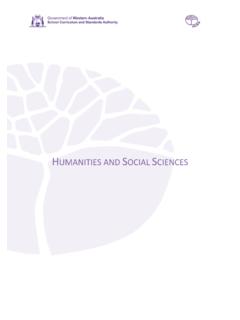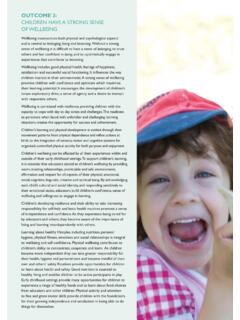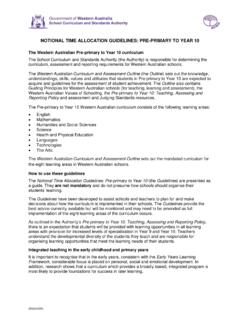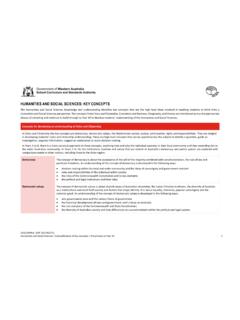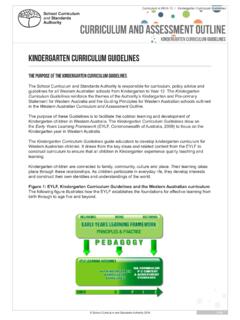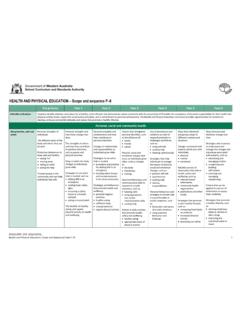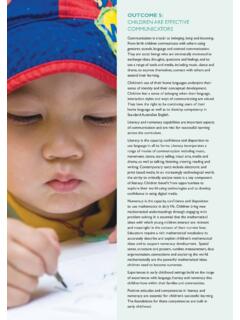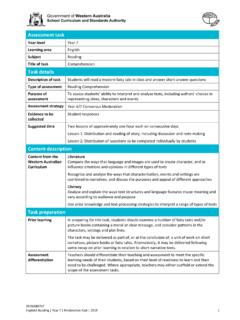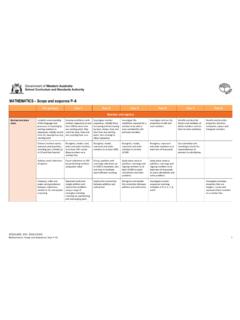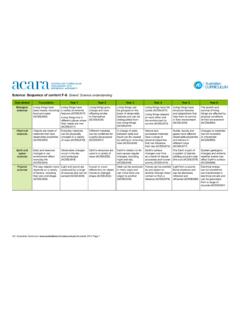Transcription of Australian Curriculum: Science - …
1 Australian curriculum : Science year views (F-10) This document presents the curriculum with content descriptions and achievement standards for each year . These documents are based on the Australian curriculum as published as version on 20/05/2013. The content description codes are hyperlinked to the Australian curriculum Website where the elaborations and links to the General Capabilities and Cross- curriculum Priorities can be viewed. Copyright School curriculum and Standards Authority, 2013 This document apart from any third party copyright material contained in it may be freely copied, or communicated on an intranet, for non-commercial purposes in educational institutions, provided that the School curriculum and Standards Authority is acknowledged as the copyright owner, and that the Authority s moral rights are not infringed.
2 Copying or communication for any other purpose can be done only within the terms of the Copyright Act 1968 or with prior written permission of the School curriculum and Standards Authority. Copying or communication of any third party copyright material can be done only within the terms of the Copyright Act 1968 or with permission of the copyright owners. Any content in this document that has been derived from the Australian curriculum may be used under the terms of the Creative Commons Attribution - Non Commercial Australia licence. School curriculum and Standards Authority 2013 Based on Australian curriculum , Assessment and Reporting Authority ( acara ) materials ( May 2013) Australian curriculum : Science (Foundation) Sub-strands Content Descriptions Achievement Standard Science understanding Biological sciences Living things have basic needs, including food and water (ACSSU002) By the end of the Foundation year , students describe the properties and behaviour of familiar objects.
3 They suggest how the environment affects them and other living things. Students share observations of familiar objects and events. Chemical sciences Objects are made of materials that have observable properties (ACSSU003) Earth and space sciences Daily and seasonal changes in our environment, including the weather, affect everyday life (ACSSU004) Physical sciences The way objects move depends on a variety of factors, including their size and shape (ACSSU005) Science as a human endeavour Nature and development of Science Science involves exploring and observing the world using the senses (ACSHE013) Use and influence of Science Science inquiry skills Questioning and predicting Respond to questions about familiar objects and events (ACSIS014)
4 Planning and conducting Explore and make observations by using the senses (ACSIS011) Processing and analysing data and information Engage in discussions about observations and use methods such as drawing to represent ideas (ACSIS233) Evaluating Communicating Share observations and ideas (ACSIS012) General Capabilities Literacy Numeracy Information and communication technology (ICT) capability Critical and creative thinking Ethical behaviour Personal and social capability Intercultural understanding Cross- curriculum Priorities Aboriginal and Torres Strait Islander histories and cultures Asia and Australia s engagement with Asia Sustainability Notes: School curriculum and Standards Authority 2013 Based on Australian curriculum , Assessment and Reporting Authority ( acara ) materials ( May 2013) Australian curriculum .
5 Science ( year 1) Sub-strands Content Descriptions Achievement Standard Science understanding Biological sciences Living things have a variety of external features (ACSSU017) Living things live in different places where their needs are met (ACSSU211) By the end of year 1, students describe objects and events that they encounter in their everyday lives, and the effects of interacting with materials and objects. They identify a range of habitats. They describe changes to things in their local environment and suggest how Science helps people care for environments. Students make predictions, and investigate everyday phenomena. They follow instructions to record and sort their observations and share their observations with others.
6 Chemical sciences Everyday materials can be physically changed in a variety of ways (ACSSU018) Earth and space sciences Observable changes occur in the sky and landscape (ACSSU019) Physical sciences Light and sound are produced by a range of sources and can be sensed (ACSSU020) Science as a human endeavour ( year 1-2) Nature and development of Science Science involves asking questions about, and describing changes in, objects and events (ACSHE021) Use and influence of Science (1-2) People use Science in their daily lives, including when caring for their environment and living things (ACSHE022) Science inquiry skills ( year 1-2) Questioning and predicting Respond to and pose questions, and make predictions about familiar objects and events (ACSIS024) Planning and conducting Participate in different types of guided investigations to explore and answer questions, such as manipulating materials, testing ideas, and accessing information sources (ACSIS025) Use informal measurements in the collection and recording of observations, with the assistance of digital technologies as appropriate (ACSIS026) Processing and analysing data and information Use a range of methods to sort information, including drawings and provided tables (ACSIS027)
7 Through discussion, compare observations with predictions (ACSIS212) Evaluating Compare observations with those of others (ACSIS213) Communicating Represent and communicate observations and ideas in a variety of ways such as oral and written language, drawing and role play (ACSIS029) General Capabilities Literacy Numeracy Information and communication technology (ICT) capability Critical and creative thinking Ethical behaviour Personal and social capability Intercultural understanding Cross- curriculum Priorities Aboriginal and Torres Strait Islander histories and cultures Asia and Australia s engagement with Asia Sustainability Notes: School curriculum and Standards Authority 2013 Based on Australian curriculum , Assessment and Reporting Authority ( acara ) materials ( May 2013) Australian curriculum .
8 Science ( year 2) Sub-strands Content Descriptions Achievement Standard Science understanding Biological sciences Living things grow, change and have offspring similar to themselves (ACSSU030) By the end of year 2, students describe changes to objects, materials and living things. They identify that certain materials and resources have different uses and describe examples of where Science is used in people s daily lives. Students pose questions about their experiences and predict outcomes of investigations. They use informal measurements to make and compare observations. They follow instructions to record and represent their observations and communicate their ideas to others.
9 Chemical sciences Different materials can be combined, including by mixing, for a particular purpose (ACSSU031) Earth and space sciences Earth s resources, including water, are used in a variety of ways (ACSSU032) Physical sciences A push or a pull affects how an object moves or changes shape (ACSSU033) Science as a human endeavour ( year 1-2) Nature and development of Science Science involves asking questions about, and describing changes in, objects and events (ACSHE021) Use and influence of Science People use Science in their daily lives, including when caring for their environment and living things (ACSHE022) Science inquiry skills ( year 1-2) Questioning and predicting Respond to and pose questions, and make predictions about familiar objects and events (ACSIS024) Planning and conducting Participate in different types of guided investigations to explore and answer questions, such as manipulating materials, testing ideas, and accessing information sources (ACSIS025) Use informal measurements in the collection and recording of observations, with the assistance of digital technologies as appropriate (ACSIS026) Processing and analysing data and information Use a range of methods to sort information, including drawings and provided tables (ACSIS027)
10 Through discussion, compare observations with predictions (ACSIS212) Evaluating Compare observations with those of others (ACSIS213) Communicating Represent and communicate observations and ideas in a variety of ways such as oral and written language, drawing and role play (ACSIS029) General Capabilities Literacy Numeracy Information and communication technology (ICT) capability Critical and creative thinking Ethical behaviour Personal and social capability Intercultural understanding Cross- curriculum Priorities Aboriginal and Torres Strait Islander histories and cultures Asia and Australia s engagement with Asia Sustainability Notes: School curriculum and Standards Authority 2013 Based on Australian curriculum , Assessment and Reporting Authority ( acara ) materials ( May 2013) Australian curriculum .
